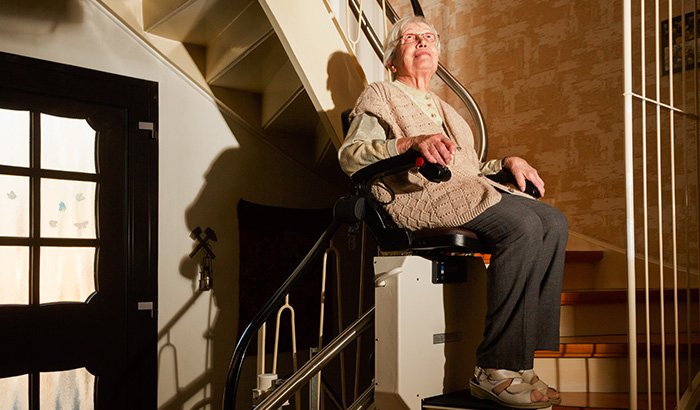6 Ways Stairlifts Give Peace of Mind
If you’re concerned about your or your loved one’s safety going up or down stairs, it might be time for a stairlift. Stairs have long been integral to our homes, facilitating movement between different levels and serving as a functional and often aesthetic feature.
However, for those facing mobility issues, aging, or physical limitations, the mere thought of navigating stairs becomes a source of anxiety and apprehension — making a mobility aid quite welcome.
The good news is with today’s technology, we have innovative devices like stairlifts designed to transform how we approach staircases.
This blog will explore how stairlifts offer a newfound sense of safety, independence, and peace of mind. From enhancing confidence to reducing the risk of accidents, stairlifts have emerged as a reliable solution, revolutionizing how we experience the challenges posed by stairs.
Let’s take a closer look.
What Is a Stairlift?
A stair lift is a specially designed mobility aid that helps individuals navigate stairs easily and safely. Picture it as a comfortable seat securely installed to a rail system on your staircase.
Here's how it works:
Seat: The seat is where you sit during your ride. It's designed for comfort and often includes features like armrests and adjustable seating options to ensure a comfortable fit for everyone.
Rail system: The rail system is the backbone of the stairlift. It's securely affixed to your staircase, providing a stable, safe path for the stairlift to move along.
Controls: Stairlifts come with user-friendly controls, usually located on the armrest or a remote control. These controls allow you to start, stop, and control the direction of the stairlift.
As a mobility aid, a stairlift is a game-changer. It provides a safe and comfortable way to move up and down the stairs.
And that’s not all. There are numerous ways stairlifts provide peace of mind. Let’s look at six ways that illustrate how beneficial they are.
6 Ways Stairlifts Help
1. Stairlifts help prevent falls. Stairlifts are exceptionally effective in preventing falls on stairs, a significant concern for individuals with mobility issues, the elderly, or anyone who finds navigating stairs challenging.
Stairlifts are sturdy, providing steady and controlled movement. This eliminates the need to climb or descend the stairs manually, reducing the risk of stumbling or losing balance.
Stairlifts are robust and durable, capable of supporting the user's weight without compromising safety. They undergo rigorous testing to meet safety standards, ensuring they reliably transport users up and down the stairs without the risk of structural failure.
A stairlift’s design has consistency in mind. The chair's height remains constant throughout the journey, eliminating the need to step up or down onto different levels. This design feature minimizes the risk of tripping or stumbling when transitioning from the stairs to the chair.
2. Stairlifts have safety features. Stairlifts come equipped with several safety features to ensure a safe ride. These often include seatbelts or harnesses that keep the user safely in place during their journey.
Stairlifts also have safety sensors on the footrest and seat, allowing them to detect obstructions in their path. This feature prevents accidents and injuries if an object becomes lodged in the moving parts.
3. Stairlifts allow you to be independent. Stairlifts are a remarkable mobility aid that empowers individuals to maintain their independence. Stairlifts allow you to move up and down stairs without needing another person to assist you.
With a stairlift, you regain access to all levels of your home, including bedrooms, bathrooms, and living spaces. This means you get to continue enjoying your entire home without limitations.
You also don’t need costly home modifications. Stairlifts are a cost-effective alternative to extensive home renovations, such as installing ramps or elevators. You can maintain your existing home layout and still move freely between floors.
Finally, it’s easier to “age in place.” For seniors, stairlifts enable you to stay in your home longer instead of moving to an assisted living facility. .
4. Stairlifts are easy to use. Stairlifts are user-friendly and straightforward to operate. They often come with intuitive controls, one-touch operation, clear and understandable symbols, a seat swivel, and an emergency stop button.
A stairlift’s intuitive controls include simple buttons or switches for functions such as moving up or down, stopping, and folding the chair.
One-touch operation means you press a single button to activate the stairlift. This simplicity minimizes the learning curve and makes the system easy to understand and use.
Control buttons have clear and universally understood symbols, making it easy to identify their functions without complex instructions.
In case of any unexpected issues or emergencies, stairlifts usually have an emergency stop button that you press to halt the chair's movement immediately.
5. Stairlifts reduce anxiety. Stairlifts may significantly reduce anxiety, especially for individuals who have experienced fear or apprehension related to using stairs.
It’s not only about the individual using the stairlift, either. Family members will rest assured that their loved one uses a safe and reliable method of moving on the stairs.
6. Stairlifts give enhanced confidence. Stairlifts substantially boost confidence by providing independence, safe movement, comfort, and convenience. With the newfound confidence that stairlifts provide, individuals regain control over their daily lives and enjoy a sense of freedom and independence within their homes.
However, it's important to recognize that before the introduction of stairlifts, stair-related accidents were a genuine concern, especially for those with mobility challenges or advancing age.
To better appreciate the significance of stairlifts in mitigating these risks, let's look at the common causes of accidents on stairs and how stairlifts serve as a reliable solution to address these challenges.
Common Causes of Accidents on Stairs
Accidents on stairs occur due to various factors and are more prevalent among older adults and individuals with mobility issues. Even with age or mobility issues, awareness helps reduce some of these accidents. So, let’s go over them.
Trips and slips: It’s not hard to slip if you step on something unexpected on the floor or if the surface is slippery.
Poor lighting: Poor lighting can make stairway features hard to see, alter your perception of step dimensions and irregularities, and conceal potential hazards.
Lack of handrails: Lack of handrails on stairways removes essential support, making it easier for people to lose their balance or slip, especially if they have a momentary misstep or are less steady on their feet.
Footwear: Improper footwear might lack the necessary grip or support for stairs, leading to slips or missteps, especially if the shoes are too loose, have worn soles, or are not suited for the stair material.
Physical impairments: Limited mobility, poor vision, or reduced strength often affect an individual's ability to navigate stairs confidently and securely, increasing the risk of missteps, loss of balance, or falls.
Visual impairments: Visual impairments can hinder a person's ability to accurately judge step dimensions, differentiate between steps and landings, or detect potential hazards on stairways.
Cognitive impairments: Cognitive impairments might affect an individual's judgment, spatial awareness, and coordination, leading to difficulty perceiving stair depth, remembering the number of steps, or reacting quickly to sudden changes.
Carrying heavy loads: Carrying heavy loads may shift an individual's center of gravity, obscure their vision of the stairs, and reduce their ability to use handrails effectively, making it harder to maintain balance.
Medications: Certain medications may cause dizziness, drowsiness, or impaired coordination, which can affect an individual's balance and stability.
Fatigue: Fatigue may reduce an individual's alertness, slow reaction times, and impair coordination, making it more challenging to navigate stairs safely.
Environmental factors: Environmental factors, such as wet or icy conditions, cluttered stairways, uneven or damaged steps, and lack of visible step markings, can create hazards or impair visibility on stairs.
Lack of handicap accessibility: The absence of ramps, elevators, or handrails forces individuals with physical limitations or mobility devices to use stairs, which can strain their abilities and heighten the risk of missteps, imbalance, or falls due to inadequate support or adaptations.
It's important to note that stairlifts, as discussed earlier, are a valuable solution to address many of these common causes of accidents on stairs. They provide a safe, reliable means of navigating stairs, particularly for individuals with mobility challenges or those who may be at greater risk of falling.
Get Your Stairlift From Salt Lake Stairlifts.
As you've discovered stairlifts' numerous benefits, you’re probably wondering where to get yours. Look no further than Salt Lake Stairlifts, your trusted partner in improving accessibility and quality of life.
Our commitment to providing top-notch stairlift solutions tailored to your specific needs is unwavering. Whether you or a loved one needs assistance navigating straight or curved staircases, our experienced team is here to guide you through the selection process, installation, and ongoing support.
With Salt Lake Stairlifts, you're not just investing in a product; you're investing in a better, safer, and more independent future. Call us at 385.993.3937, or fill out our contact form to get in touch with us today.



